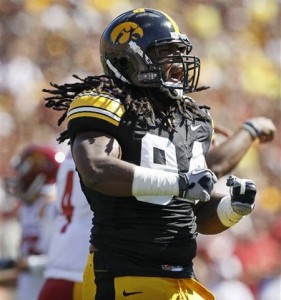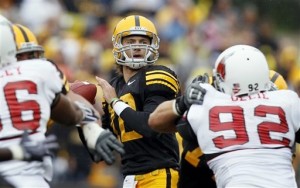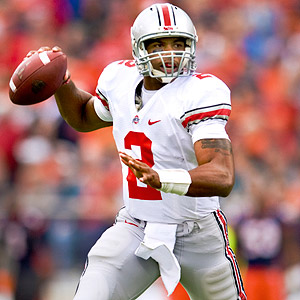Final Chapter of Iowa Football: A Tale of Two Seasons in 2010
It was the best of times, it was the worst of times, it was the age of wisdom, it was the age of foolishness…it was the season of Light…Charles Dickens, A Tale of Two Cities
Redemption came at last in the Arizona desert where the first warning bell tolled against a predicted preeminent Iowa football season.
Iowa,who started college football in August as the media darling of the Big Ten, reportedly fielded one of the best defenses in the nation. Indeed, Iowa’s front four proved to one of the best quartets in college football.
But even they needed help from the linebacker corps and the secondary to contain an assemblage of top-ranked quarterbacks who spread their opposing offenses, often picking apart even Iowa’s well-oiled defense.
Unfortunately for the Iowa D, the Hawkeye’s defensive coordinator, Norm Parker, was sidelined for the season in September after undergoing surgery to amputate his right foot, necessitated by complications of diabetes.
Furthermore mounting injuries practically decimated the Hawkeye linebacker corps as well as limiting or sidelining other key defensive personnel.
The first real chink, however, appeared in Tucson where the No. 24 Arizona Wildcats upset Iowa in an unusual game for the highly vaunted No. 9 Iowa Hawkeyes.
In the first five minutes Iowa endured a blocked punt and an interception, sending Arizona up 14-0. Iowa scored a touchdown in the second quarter but Arizona returned the subsequent kickoff for 100 yards and another score—plus two field goals. Arizona was up 27-7 at the half.
Scoring another touchdown in the third quarter, Iowa climbed seven points closer. The Hawkeye’s defense had clamped down hard on the Wildcats, holding them scoreless well into the second half.
In the fourth quarter another Ricky Stanzi pass added another seven, leaving Iowa trailing only 27-21. At that point Broderick Binns intercepted a Nick Foles pass and returned it 20 yards for a score to break things wide open. But Trent Mussbrucker’s PAT was blocked and the score remained tied at 27-27.
Arizona promptly marched down the field and scored their first legitimate touchdown of the game. Iowa could not answer. The Hawkeyes lost 34-27 after a tremendous effort to come back in the second half fell short at the end.
Iowa’s lapses on special teams and Iowa’s inability to close out close games at the end of the season—all foreshadowed in this loss to Arizona in September.
It seemed to many that maybe the Arizona game was an aberration when Iowa won their next three games over Ball State, Penn State and Michigan.
When Wisconsin came calling at Kinnick Stadium on October 23, most people, except Badger fans, felt Iowa would win that game.
Iowa led 30-24 in the fourth quarter and seemed in complete control of the game. Wisconsin lined up to punt the ball away on a fourth down. It was a fake that completely fooled the Hawkeyes as the Badgers made the required yardage and kept possession of the ball.
The fake punt kept the Badger drive alive, allowing Montee Ball to run the ball in from 8 yards out with 1:06 left on the clock. The Badgers took the lead 31-30.
Iowa failed to score in the final minute as time expired before Adam Robinson could step out of bounds. The whole stadium in Iowa City was stunned by the turn of events because Iowa led throughout the game and let a trick play spoil their 5-1 record.
Iowa, however, bounced back to win against Michigan State. In fact they dominated the No. 5 Spartans 37-6 in Iowa City. The Hawkeyes followed that victory by winning a close one against Indiana in Bloomington.
In fact, Iowa was lucky to get away with a win over the Hoosiers, scoring their first touchdown of the afternoon late in the fourth quarter. It seemed that the Iowa offense spent most of the afternoon stalling out in the red zone.
When November hit, so did the brakes on Hawkeye Rose Bowl hopes. Iowa began to falter, seemed uncertain, and watched as any semblance of luck drained completely from their ranks.
Iowa lost their last three games of the regular season against Northwestern where they held a 17-7 lead going into the fourth quarter but could not close out the game—allowing Northwestern to come back and win 21-17.
Against Ohio State Iowa led 17-10 going into the fourth quarter. The Buckeyes kicked a field goal. Then, the Hawkeyes led 17-13 until Dan Herron ran it in from one yard out to score giving the Buckeyes a 20-17 win, leaving Iowa reeling.
But the final indignity of the season came in losing to the last place Minnesota Gophers 27-24 as the dreams of glory at the beginning of the season evaporated completely. It was as if the football Gods were doling out the ultimate punishment for a season where this team aimed too high.
The off-season continued to promulgate bad news finding new mud to throw Iowa’s way. First was the news that Iowa’s all-time leading receiver Derrell Johnson-Koulianos was arrested on drug charges. Iowa Coach Kirk Ferentz dismissed DJK from the team.
At approximately the same time, Adam Robinson, Iowa’s leading running back was suspended for the Insight Bowl for unspecified reasons dealing with not living up to team expectations.
Rumors also began to spread throughout the media that other players, in addition to DJK would be suspended.
That turned out to be untrue but still the rumors swirled. Just prior to the start of the Insight Bowl, Adam Robinson was picked up and charged with drug possession. As far as his return to the Iowa squad, no final word came from Ferentz regarding Robinson’s present and future status.
Needless to say with the collapse in November and all the bad press in December, Iowa took the field against the No. 12 Missouri Tigers as decided underdogs. They did not, however, play like a down and out football team.
To their credit, Iowa regrouped, found their core, and proceeded to play the kind of football they played earlier in the season with belief and composure, led by 25 seniors playing their last college football game. All of this against a really good team led by an outstanding quarterback, Blaine Gabbert.
It stands to reason that Iowa would miss its leading ground-gainer, Adam Robinson, and its leading receiver, Derrell Johnson-Koulianos but the Iowa team closed the door on that and instead gave the ball to Marcus Coker who set the field on fire with his yardage, overpowering one of the best run defenses in the country.
The Missouri Tigers could not stop him as Coker amassed 219 yards on 33 carries, scoring two touchdowns. His longest scoring run was 62 yards. It was quite a night for the young man from Beltsville, MD.
Iowa led throughout the game until the end of the third quarter when Missouri finally squeezed ahead by four points 24-20. But Iowa was the only team that answered the bell in the fourth quarter, coming back to score when Micah Hyde intercepted a Gabbert pass, running it back 72 yards for the score and the win.
Even though Gabbert threw for 434 yards and even though his receivers T.J. Moe and Jerrell Jackson caught passes for 152 yards and 129 yards, respectively, Iowa won the game because of a team effort.
Iowa won this game, and in the process redeemed the season that seemed to offer so much promise back in September…



